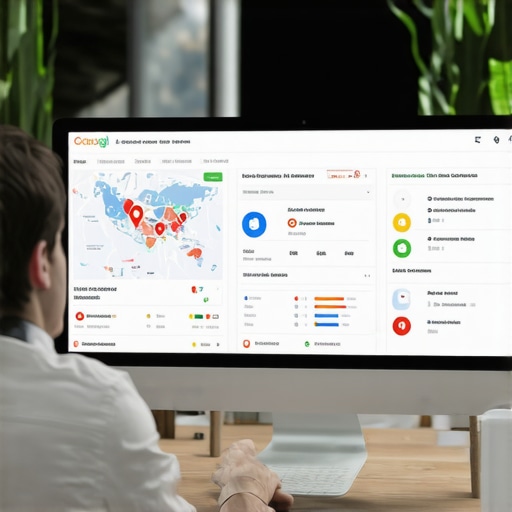Unveiling the Complexities of Google Maps SEO: A Strategic Perspective
In an era where local search visibility is paramount for business success, mastering Google Maps SEO requires a nuanced understanding of its multifaceted algorithms. As digital landscapes evolve, so too must the tactics that drive prominence on Google Maps. This article explores expert-level strategies tailored for seasoned marketers aiming to dominate local search results in 2024.
Deciphering the Algorithmic Underpinnings of Google Maps Rankings
What are the core factors influencing Google Maps visibility, and how can they be optimized in tandem?
The ranking determinants for Google Maps involve a complex interplay of relevance, distance, and prominence. Advanced practitioners leverage structured data schemas, consistent NAP (Name, Address, Phone number) citations, and authoritative backlinks to enhance relevance and authority. Simultaneously, optimizing for proximity involves precise geotagging and local intent signals. Understanding these components through tools like Search Engine Land can provide a competitive edge.
Implementing Niche-Specific Local SEO Tactics for Maps
Beyond generic optimization, niche-specific strategies—such as utilizing industry-relevant keywords in Google My Business descriptions, and embedding schema markup—are crucial. For instance, restaurants should focus on menu schema, while service providers might emphasize service-specific keywords. These tactics, when aligned with evolving Google policies, significantly boost local ranking precision.
How Can Engagement Metrics Elevate Maps Search Rankings?
Engagement signals like reviews, ratings, and user interactions serve as social proof and trust indicators. Encouraging authentic customer reviews and responding thoughtfully enhances credibility. Tools like reputation management platforms can automate review solicitation, but maintaining genuine engagement remains essential to uphold trustworthiness and authority.
Expert Insight: How do Local Link Building and Citation Consistency Impact Rankings?
High-quality local backlinks and citation consistency are cornerstones of authoritative presence. Strategic outreach to local business directories, industry associations, and community platforms can generate valuable inbound links. Ensuring citation uniformity across all online listings mitigates confusion and reinforces trust signals, as corroborated by recent white papers from Moz.
Can Advanced Content Optimization Further Dominate Maps SEO?
Indeed, content strategies that integrate local-specific keywords, multimedia elements, and user-generated content can diversify relevance signals. Embedding Google Map embeds within your website and optimizing image alt texts with geo-specific keywords facilitate better indexing and ranking.
What are the emerging trends and open debates in Google Maps SEO for 2024?
Ongoing debates center around the impact of AI-driven personalization and voice search optimization on local rankings. As voice-activated queries rise, optimizing for conversational keywords and featured snippets becomes increasingly vital. Staying abreast of updates via trusted sources like Search Engine Land is advisable for practitioners seeking to adapt swiftly.
For those committed to elevating their local visibility, exploring comprehensive strategies outlined in this guide offers a foundational blueprint. Share your insights or query expert opinions to refine your approach further.
Refining Your Local Signal Ecosystem for Superior Maps Rankings
Mastering Google Maps SEO in 2024 involves more than just optimizing listings; it requires a holistic approach to your local signal ecosystem. This includes enhancing your NAP consistency, leveraging structured data, and cultivating a robust backlink profile from authoritative local sources. When these elements work synergistically, your visibility on Google Maps can significantly outperform competitors. For deeper insights, explore this comprehensive guide on local SEO best practices.
How Does User Behavior Shape Future Map Rankings?
Emerging evidence suggests that user engagement metrics—such as click-through rates, review velocity, and interaction depth—are becoming pivotal ranking factors. Advanced algorithms analyze patterns of customer behavior to prioritize listings that demonstrate active user engagement. This shift underscores the importance of proactive review management and interactive content. For practical implementation, consider tools like reputation management platforms to automate review solicitation and response strategies, thus enhancing your rankings.
Can Strategic Content and Multimedia Integration Turbocharge Your Local SEO?
Absolutely. Embedding multimedia—such as photos, videos, and 360-degree tours—within your Google My Business profile can dramatically improve user engagement and dwell time, signaling relevance to Google’s algorithm. Furthermore, integrating local keywords naturally into your website content, blog posts, and schema markup can trigger more accurate indexing. For instance, a service provider might embed a Google Map widget directly into their site, coupled with geo-targeted schema, to reinforce local relevance. To stay ahead, review this expert resource on multimedia and content optimization for maps SEO.
What innovative tools or frameworks can give your local SEO strategy a competitive edge in 2024?
Leveraging advanced analytics platforms like BrightLocal or Whitespark can unveil granular insights into local ranking factors, citation health, and competitor analysis. Additionally, adopting a structured testing framework—such as A/B split testing for listing updates—can systematically identify what adjustments yield the best results. Continuous monitoring through these tools enables data-driven decision-making, essential for adapting to evolving Google algorithms. For further guidance, consider reviewing this in-depth strategy outline.
Harnessing the Power of Schema Markup for Local Authority and Visibility
One of the most potent yet underutilized tools in local SEO is schema markup, particularly schema.org structured data tailored for local businesses. Implementing detailed schema—such as LocalBusiness, Service, and Product schemas—not only enhances your listing’s appearance in search results but also signals relevance and authority to Google. For instance, embedding menu schema for restaurants or service-specific schemas for professionals can significantly improve your chances of appearing in rich snippets and localized knowledge panels. According to Moz’s recent white paper on schema implementation, properly structured data can improve click-through rates by up to 20%, making it an essential component of any advanced local SEO strategy.
Leveraging AI and Machine Learning to Predict and Influence Local Search Trends
The integration of AI-driven analytics platforms enables marketers to predict shifts in local search behaviors and adapt their strategies proactively. Tools like BrightLocal have begun incorporating machine learning algorithms that analyze review velocity, competitor movements, and user engagement patterns to forecast future ranking fluctuations. By understanding these predictive insights, advanced practitioners can optimize their listings, content, and engagement tactics before algorithm updates impact their visibility. As Google increasingly leverages AI, mastering these predictive tools becomes vital to maintain a competitive edge. For comprehensive strategies on utilizing AI in local SEO, consult specialized reports from industry leaders such as Search Engine Journal.
What is the role of Local Content Clusters in Enhancing Map Rankings?
Building on traditional content optimization, the concept of local content clusters involves creating interconnected, geo-targeted content hubs around core business themes. These clusters include blog posts, FAQs, video content, and user-generated reviews—all optimized for local intent keywords. When these content hubs are linked internally and include schema markup, they create a robust topical authority that signals relevance and trustworthiness to Google. For example, a legal practice might develop a cluster around family law topics in a specific city, integrating case studies, testimonials, and service pages. This approach not only improves organic rankings but also enhances local map visibility by reinforcing topical relevance and engagement signals.
Integrating Voice Search Optimization for Hyper-Local Queries
With voice search usage soaring, optimizing for conversational, local queries is a critical frontier in Google Maps SEO. Advanced strategies involve crafting natural language content that matches how users speak, incorporating question-based keywords, and leveraging featured snippets. For instance, a user might ask, “Where’s the best coffee shop near me open now?” Optimizing your Google My Business profile with timely updates, accurate hours, and localized FAQ content can boost your chances of appearing in voice search results. Moreover, integrating structured data helps voice assistants understand your business details more accurately, ensuring your listing is considered authoritative for hyper-local queries. As voice search continues to evolve, staying ahead with this optimization is crucial for maintaining top-tier local visibility.

Visualize the integration of schema markup within a local business website, showcasing structured data snippets and rich results in search listings.
Harnessing AI and Machine Learning to Preemptive Local Search Optimization
As the digital landscape becomes increasingly sophisticated, the integration of AI and machine learning in local SEO offers unprecedented opportunities for strategic foresight. Advanced practitioners leverage predictive analytics tools such as BrightLocal or SEMrush to identify impending shifts in user behavior, competitor movements, and algorithm updates. These insights enable preemptive adjustments, allowing businesses to optimize their Google Maps presence before ranking fluctuations occur. Understanding how these intelligent systems analyze review patterns, engagement metrics, and citation health is crucial for staying ahead in competitive local markets. For an in-depth exploration of AI-driven local SEO, consult authoritative sources like Moz’s latest white paper on machine learning applications in search optimization.
What Role Do Local Content Clusters Play in Enhancing Map Visibility?
Developing comprehensive local content clusters involves creating interconnected, geo-targeted content hubs that reinforce topical authority and relevance. These clusters include blog posts, FAQ pages, multimedia content, and user-generated reviews, all optimized for local keywords and embedded with schema markup. For example, a healthcare provider might develop a cluster around specialized services in a specific city, integrating patient testimonials, service descriptions, and localized informational articles. Such an approach improves organic rankings and strengthens Google Maps visibility by signaling topical relevance and fostering user engagement. Internal linking within these clusters further amplifies authority signals, making this strategy indispensable for advanced local SEO practitioners.
How Can Voice Search and Conversational AI Revolutionize Hyper-Local SEO Tactics?
The rapid rise of voice search necessitates a paradigm shift toward conversational and natural language optimization. Advanced strategies involve crafting content that mirrors how users naturally inquire about local services, including question-based keywords and long-tail phrases. Implementing structured data, such as FAQ schema, enhances the likelihood of appearing in voice snippets. For instance, optimizing a Google My Business profile with frequently asked questions about operating hours or services can significantly improve voice search rankings. As AI-driven voice assistants become more context-aware, aligning your content with user intent in a conversational manner ensures your business remains prominent in hyper-local voice search results. Staying informed on evolving voice AI capabilities via industry leaders like Search Engine Journal is essential for maintaining a competitive edge.

Visualize the integration of conversational AI in local SEO, showing voice search interactions and optimized business profiles in a smart device interface.
Expert Insights & Advanced Considerations
1. Emphasize the Power of Local Content Clusters
Creating interconnected, geo-targeted content hubs around core business themes enhances topical authority and signals relevance to Google, boosting map rankings and organic visibility.
2. Leverage AI-Driven Predictive Analytics
Utilize tools like BrightLocal and SEMrush to forecast shifts in local search behaviors and adapt your strategies proactively, maintaining a competitive edge in Google Maps SEO.
3. Prioritize Schema Markup Implementation
Implement detailed local business schemas such as LocalBusiness, Service, and Product to improve rich snippet appearances and establish authoritative signals in search results.
4. Optimize for Voice Search and Conversational AI
Tailor content for natural language queries and question-based keywords, integrating structured data to enhance visibility in hyper-local voice search results.
5. Cultivate a Robust Local Link Profile
Engage in strategic outreach to local directories, industry groups, and community platforms to generate high-quality backlinks and ensure citation consistency across all listings.
Curated Expert Resources
- Google’s Official My Business Blog: Provides the latest updates and best practices directly from Google, essential for staying current with platform changes.
- Moz’s Schema Markup Guide: Offers in-depth tutorials on implementing structured data to enhance local SEO and rich snippet appearances.
- BrightLocal Blog: Features advanced analytics, local SEO strategies, and predictive tools insights from industry leaders.
- Search Engine Journal: Covers emerging trends in AI, voice search, and algorithm updates affecting maps SEO.
- White Papers from Moz and Ahrefs: Deliver comprehensive research and case studies on local link building, citation management, and schema optimization.
Final Expert Perspective
Mastering Google Maps SEO in 2024 demands a strategic blend of authoritative content clustering, innovative AI utilization, and precise technical optimization such as schema markup and voice search adaptation. Staying ahead in this evolving landscape requires continuous learning from authoritative resources and proactive strategy adjustments. For those committed to excellence, exploring these advanced insights and tools can significantly elevate your local visibility and rankings. Engage with industry leaders, share your insights, and refine your approach to dominate local search results effectively.




Samantha Green
I found the emphasis on schema markup particularly insightful. In my experience managing local SEO for a chain of cafes, detailed schema implementation, especially for menus and reviews, has noticeably improved our rich snippets and click-through rates. What are some best practices for keeping schema data up-to-date without overwhelming the management team? I’ve noticed that Google tends to prioritize freshness, so automating or streamlining this process could be a game-changer. Also, the discussion around AI-driven analytics tools like BrightLocal is fascinating. Has anyone here used these tools to anticipate local ranking shifts and adjusted their strategies preemptively? I’d love to hear success stories or tips on integrating predictive analytics into ongoing SEO efforts. Overall, staying proactive with these advanced tactics seems essential to stay ahead in such a competitive landscape.